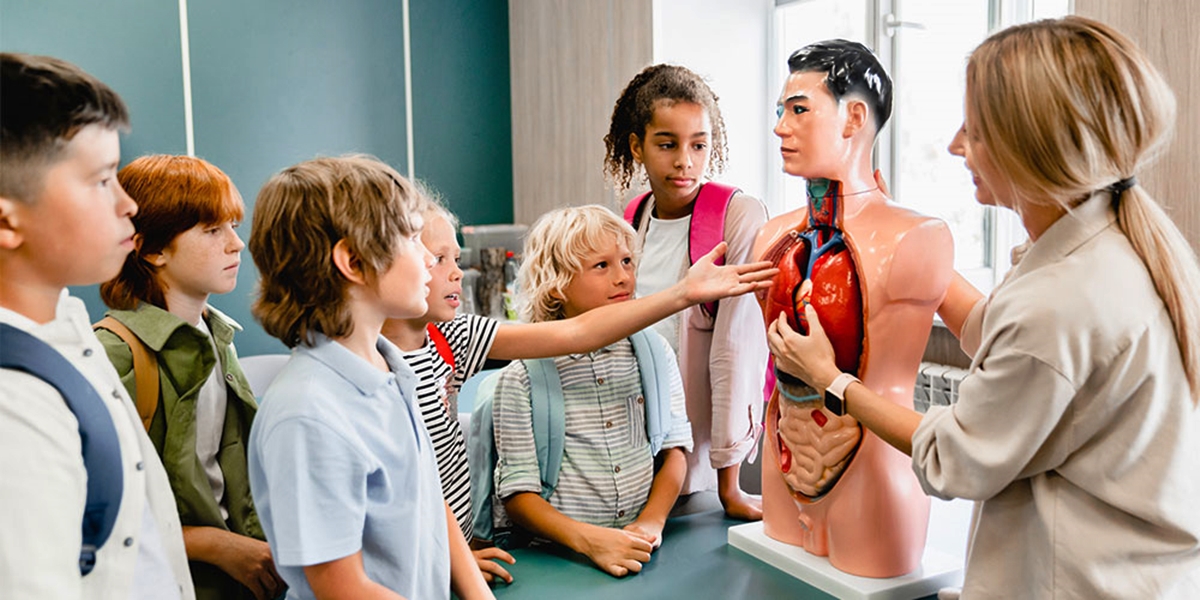

Featured
What Is Health Class
Modified: January 2, 2024
Discover what Health Class is and why it is featured in schools. Gain insights into important topics and skills for overall well-being.
Introduction
Health education plays a crucial role in equipping individuals with the knowledge and skills necessary to make informed decisions about their well-being. As a vital component of the education system, health class aims to promote physical, mental, and social well-being among students. This comprehensive subject covers a wide range of topics, enabling students to understand the importance of maintaining a healthy lifestyle and making positive choices.
Health education is not limited to providing information about the human body and its functions, but also encompasses social and emotional aspects of health. It addresses issues such as nutrition, exercise, mental health, sexual education, substance abuse prevention, and disease prevention. By addressing these topics, health class empowers students to lead healthier lives and make informed decisions.
The benefits of health class extend beyond the classroom. By educating students about healthy behaviors, health class plays an essential role in shaping future generations. It equips students with the necessary tools to advocate for their well-being and make positive changes at an individual and community level.
In this article, we will explore the importance of health education, the topics covered in health class, the benefits it provides, the teaching methods used, and its impact on student well-being. We will also discuss the challenges and controversies surrounding health education and how its effectiveness is evaluated. Let us delve into the fascinating world of health class and its impact on students’ lives.
Importance of Health Education
Health education holds immense importance in equipping individuals with the knowledge and skills necessary to lead healthy and fulfilling lives. It empowers students with the tools to make informed decisions, develop healthy habits, and navigate the challenges they may face in their physical, mental, and social well-being.
One of the primary reasons health education is essential is its role in disease prevention. By teaching students about proper hygiene, nutrition, and the importance of physical activity, health class plays a crucial role in reducing the risk of chronic diseases such as obesity, diabetes, and heart disease. It provides students with the knowledge to make healthy choices, helping them establish a strong foundation for a lifetime of positive health outcomes.
In addition to physical health, health education also focuses on mental and emotional well-being. It addresses issues such as stress management, coping mechanisms, self-care strategies, and the importance of seeking help when needed. By promoting mental health literacy, health class equips students with the resources to recognize, understand, and support their mental well-being.
Furthermore, health education plays a vital role in promoting healthy relationships and preventing risky behaviors. By teaching students about consent, healthy communication, and the importance of respect, health class empowers them to maintain healthy relationships and make responsible choices regarding their sexual health.
Health education also serves as a gateway to addressing social issues and promoting social justice. It encourages discussions about topics such as gender equality, racial disparities in healthcare, and environmental health. By fostering critical thinking and promoting inclusivity, health education prepares students to become advocates for a healthier and more equitable society.
Moreover, health education provides students with life skills that extend beyond the classroom. It teaches them to set goals, make informed decisions, and practice critical thinking. These skills are essential for their overall personal development and enable them to navigate challenges and make healthy choices throughout their lives.
In sum, health education is of paramount importance as it empowers students to take control of their health and well-being. It equips them with the knowledge, skills, and attitudes necessary to lead healthy lives, prevent diseases, maintain positive relationships, and advocate for themselves and others. The impact of health education extends far beyond the classroom, creating a ripple effect that positively influences individuals, families, communities, and society as a whole.
Topics Covered in Health Class
Health class covers a wide range of topics that aim to provide students with a comprehensive understanding of various aspects of health and well-being. The curriculum is designed to address physical, mental, and social health, equipping students with the knowledge and skills necessary to make informed decisions and lead healthy lives.
One of the core topics covered in health class is nutrition and healthy eating. Students learn about the importance of a balanced diet, food groups, portion sizes, and the impact of nutrition on overall health. They also learn how to read food labels, make healthier food choices, and develop good eating habits.
Physical activity and exercise are also major components of health class. Students learn about the benefits of regular physical activity and the different types of exercise that promote cardiovascular fitness, muscular strength, and flexibility. This includes discussions on the significance of staying active, incorporating exercise into daily routines, and the importance of avoiding a sedentary lifestyle.
Mental health and emotional well-being are addressed in health class as well. Students learn about strategies for managing stress, building resilience, and promoting positive mental health. They also explore topics such as self-esteem, body image, and the impact of emotions on overall well-being. Additionally, discussions on mental disorders, their stigmas, and the importance of seeking support and treatment are conducted.
Sexual education is another important topic covered in health class. This includes discussions on reproductive health, contraception methods, and the prevention of sexually transmitted infections. Students are educated about consent, healthy relationships, and the importance of practicing safe and responsible sexual behavior.
Substance abuse prevention is also a key focus in health class. Students learn about the risks and consequences of substance abuse, including tobacco, alcohol, and drugs. They are educated on the importance of making informed decisions, resisting peer pressure, and seeking help if needed.
In addition to these core topics, health class may also cover other relevant issues such as environmental health, first aid and safety, the impact of media on health behaviors, and the importance of sleep and rest. The curriculum is designed to provide a well-rounded understanding of various health-related topics, allowing students to develop the necessary knowledge and skills to make informed decisions and live healthy lives.
Benefits of Health Class
Health class offers numerous benefits that extend far beyond the classroom. By providing students with essential knowledge and skills, it empowers them to lead healthier lives and make informed decisions about their well-being. Let’s explore some of the key benefits that health class provides.
1. Promotes Physical Well-being: Health class educates students about the importance of nutrition, exercise, and healthy habits. By equipping them with this knowledge, it encourages regular physical activity, healthy eating, and the maintenance of a healthy weight. This promotes physical well-being and reduces the risk of chronic diseases such as obesity, heart disease, and diabetes.
2. Enhances Mental Health: Health education addresses mental health issues and provides students with strategies to manage stress, build resilience, and promote positive emotional well-being. Discussing topics such as self-esteem, body image, and coping mechanisms helps students develop a greater understanding of their mental health and fosters a supportive environment.
3. Encourages Healthy Relationships: Health class teaches students about topics such as consent, communication, and respecting boundaries. By promoting a culture of healthy relationships, it equips students with the necessary skills to build and maintain positive connections with their peers and potential romantic partners.
4. Prevents Risky Behaviors: Health education plays a crucial role in reducing risky behaviors such as substance abuse and unsafe sexual practices. By providing accurate information and discussing the consequences of these behaviors, it empowers students to make responsible choices and avoid potential harm.
5. Builds Life Skills: Health class equips students with essential life skills that can be applied beyond their school years. These skills include critical thinking, decision-making, problem-solving, and effective communication. These skills not only contribute to their overall personal development but also prepare them for success in various aspects of their lives.
6. Promotes Inclusivity: Health education provides an opportunity to discuss sensitive topics such as gender identity, sexuality, and cultural diversity. By fostering an inclusive environment, it helps students develop empathy, acceptance, and understanding for individuals from diverse backgrounds.
7. Empowers Students: Health education empowers students to take ownership of their own well-being. By providing them with accurate information, it enables them to make informed decisions and advocate for their health. This sense of empowerment can have a positive impact on their overall self-confidence and self-esteem.
Overall, health class plays a vital role in promoting the physical, mental, and social well-being of students. By equipping them with knowledge, skills, and resources, it sets the foundation for a lifetime of healthy choices and fosters a positive and supportive environment for their overall well-being.
Teaching Methods Used in Health Class
Health class employs various teaching methods to engage students and enhance their understanding of health-related topics. These methods aim to create an interactive and participatory learning environment that encourages active engagement and critical thinking. Let’s explore some of the commonly used teaching methods in health class.
1. Classroom Discussions: Classroom discussions are a key element of health class. They allow students to share their thoughts, perspectives, and experiences regarding health-related topics. Through guided discussions, students can explore various viewpoints, challenge assumptions, and broaden their understanding of health issues.
2. Multimedia Presentations: Multimedia presentations such as videos, slideshows, and interactive presentations are commonly used in health class. These audio-visual aids help illustrate complex concepts and engage students through visual and auditory means. They can include real-life examples, case studies, and expert interviews to enhance understanding.
3. Role-Playing and Simulations: Role-playing and simulations provide a hands-on and experiential approach to learning in health class. Students may participate in scenarios that simulate real-life situations, allowing them to practice decision-making, communication skills, and problem-solving in a safe environment. This method helps students develop practical skills and empathy.
4. Group Activities and Projects: Collaborative group activities and projects encourage teamwork, communication, and critical thinking. Students work together to research, analyze, and present information on a specific health topic. This method fosters active engagement, enhances research skills, and promotes effective communication and collaboration.
5. Interactive Workshops and Demonstrations: Health class often incorporates interactive workshops and demonstrations to promote hands-on learning. These can include activities such as cooking demonstrations to teach healthy recipes, first aid workshops to learn emergency response techniques, or fitness sessions to experience different exercise routines. By actively participating in these activities, students gain practical knowledge and develop skills.
6. Guest Speakers and Expert Presentations: Inviting guest speakers or experts in the field of health to share their knowledge and experiences can provide valuable insights for students. These sessions expose students to diverse perspectives and real-world applications of health concepts. They can also inspire students to pursue careers in health-related fields.
7. Technology Integration: Integrating technology into health class can enhance learning experiences. Online resources, educational websites, and health-related apps can be utilized to supplement classroom instruction. Interactive quizzes, online discussions, and virtual simulations can also be incorporated to engage students and reinforce learning.
Incorporating these teaching methods ensures that health class is dynamic and engaging, providing students with a variety of opportunities to learn, voice their opinions, and apply health concepts to real-life situations. By fostering active participation and critical thinking, these methods contribute to a comprehensive and impactful learning experience.
Role of Health Class in Promoting Healthy Behaviors
Health class plays a critical role in promoting healthy behaviors among students. By providing comprehensive education and fostering a supportive learning environment, health class equips students with the knowledge, skills, and motivation to make positive lifestyle choices. Let’s explore the key ways in which health class promotes healthy behaviors.
1. Education and Awareness: Health class provides students with accurate and up-to-date information about various health-related topics. By educating students on topics such as nutrition, physical activity, mental health, and sexual health, it raises awareness about the importance of making healthy choices. It expands students’ knowledge and empowers them to make informed decisions regarding their well-being.
2. Developing Healthy Habits: Health class emphasizes the development of healthy habits and behaviors. Students learn about the benefits of regular physical activity, proper nutrition, and adequate sleep. They are encouraged to adopt sustainable healthy habits, such as incorporating exercise into their daily routines, making nutritious food choices, and practicing good hygiene. By instilling these habits early on, health class sets a foundation for a lifetime of well-being.
3. Building Skills for Healthy Decision-Making: Health class equips students with the skills necessary to make healthy decisions. Students learn critical thinking, problem-solving, and decision-making skills that are applicable to various health-related situations. They explore strategies for analyzing risks and benefits, evaluating sources of information, and considering the consequences of their actions. This enables them to make informed choices that promote their well-being.
4. Peer Influence and Support: Health class fosters a supportive environment where students discuss and share their experiences openly. This promotes positive peer influence and support. Through classroom discussions, group activities, and collaborative projects, students can learn from each other, share strategies for maintaining healthy behaviors, and provide encouragement and motivation to their peers. This creates a sense of community and reinforces the importance of healthy behaviors.
5. Prevention of Risky Behaviors: Health class educates students about the risks associated with various unhealthy behaviors, such as substance abuse, unsafe sex, and unhealthy relationships. By discussing the consequences of these behaviors and providing strategies for prevention, health class helps students develop the knowledge and skills to avoid risky behaviors. It empowers students to make responsible choices that prioritize their well-being.
6. Setting Realistic Goals: Health class encourages students to set realistic goals for their well-being. Whether it’s setting goals for physical fitness, nutrition, or mental health, students learn the importance of goal-setting, planning, and tracking progress. This helps them establish positive habits and maintain motivation towards achieving their health goals.
7. Cultivating a Healthier Future Generation: By promoting healthy behaviors and providing comprehensive education, health class plays a crucial role in shaping the future generation. As students carry the knowledge and skills gained from health class into their adult lives, they become advocates for their own well-being and positive influencers in their communities. The impact of health class extends beyond the classroom to create a healthier society overall.
In summary, health class plays a vital role in promoting healthy behaviors among students. By providing education, building skills, fostering peer support, and emphasizing the importance of prevention, health class empowers students to make informed choices and develop sustainable healthy habits. Through its comprehensive approach, health class equips students with the tools to lead healthier lives and contribute to the well-being of their communities.
Challenges and Controversies in Health Education
While health education is a vital component of a comprehensive education system, it is not without its challenges and controversies. The sensitive nature of some health-related topics and varying societal perspectives on these issues can create obstacles in delivering effective health education. Let’s explore some of the common challenges and controversies faced in health education.
1. Taboo and Sensitive Topics: Health education often addresses sensitive topics such as sexuality, reproductive health, substance abuse, and mental health. These topics are considered taboo in some cultures or communities, leading to resistance or discomfort in discussing them openly. Educators must navigate these sensitivities while ensuring that students receive accurate information and support in these areas.
2. Controversial Curriculum and Parental Concerns: The development of health curriculum can be a contentious issue as it involves determining the appropriate level of detail and including topics that align with societal values. Some parents may have concerns about the content covered in health class, particularly when it comes to discussions on sexuality, contraception, or substance abuse prevention. Balancing these concerns while providing age-appropriate and evidence-based education is a challenge faced by educators.
3. Limited Instructional Time: Health education is often given less instructional time compared to other subjects. This limited time frame can restrict the depth and breadth of topics covered in health class. Teachers must prioritize certain topics, leaving others underrepresented or neglected. It can be challenging to provide comprehensive education within the time constraints allocated to health education.
4. Varying State and Local Standards: Health education standards and guidelines can differ between states and localities, leading to inconsistency in the content and quality of health education provided. The lack of standardized curriculum can result in gaps in knowledge and skills among students, depending on where they receive their education.
5. Lack of Teacher Training and Resources: Not all health educators receive adequate training and support to effectively teach health education. Some educators may lack confidence or proper training in teaching sensitive topics or incorporating interactive teaching methods. Additionally, limited access to up-to-date resources and teaching materials may hinder the delivery of comprehensive and engaging health education.
6. Cultural and Value Differences: Health education needs to address cultural and value differences among students and their families. Some cultural or religious beliefs may conflict with certain health education teachings. Finding a balance between respecting cultural diversity and delivering evidence-based information can be a challenge for educators.
7. Evaluating Impact and Effectiveness: Assessing the impact and effectiveness of health education programs can be complex. In addition to tracking changes in knowledge and behavior, evaluating the long-term impact on student health outcomes can be challenging. Gathering reliable data and measuring the effectiveness of health education initiatives requires thorough evaluation methods and resources.
Despite these challenges and controversies, health education remains crucial in equipping students with essential knowledge and skills to make informed decisions about their well-being. By addressing these challenges head-on, educators can work towards providing inclusive, evidence-based, and comprehensive health education that meets the needs of diverse student populations.
Impact of Health Class on Student Well-being
Health class has a significant impact on student well-being, encompassing their physical, mental, and social health. By providing comprehensive education, promoting healthy behaviors, and fostering a supportive learning environment, health class plays a crucial role in shaping and enhancing students’ overall well-being. Let’s explore the key ways in which health class positively impacts student well-being.
1. Knowledge and Awareness: Health class equips students with knowledge and awareness about various health-related topics. Students gain a deeper understanding of their bodies, the importance of preventive care, and strategies for maintaining physical health. They also develop awareness about mental health, sexual health, and substance abuse prevention. This increased knowledge empowers students to make informed decisions, leading to better overall well-being.
2. Healthy Behaviors and Habits: Health class promotes healthy behaviors and habits among students. Through education and discussions, students learn about the benefits of regular physical activity, balanced nutrition, and healthy sleep patterns. They develop skills to manage stress, build resilience, and maintain positive mental health. By adopting these healthy behaviors, students enhance their overall well-being and reduce the risk of chronic diseases.
3. Positive Self-Image and Self-Esteem: By addressing topics such as self-esteem, body image, and healthy relationships, health class helps students develop a positive self-image and self-esteem. Students learn to appreciate and accept themselves, embrace their unique qualities, and develop healthy relationships with both themselves and others. This positive self-image contributes to their overall well-being and mental health.
4. Responsible Decision-Making: Health class equips students with the skills to make responsible decisions regarding their health and well-being. They learn to analyze risks and benefits, evaluate options, and consider the consequences of their actions. This helps students make informed choices related to nutrition, physical activity, relationships, and substance use. Responsible decision-making leads to healthier outcomes and enhances students’ overall well-being.
5. Improved Interpersonal Skills: Health class fosters the development of essential interpersonal skills among students. Through discussions, group activities, and workshops, students learn effective communication, active listening, empathy, and conflict resolution. These skills support positive relationships, enhance social connections, and contribute to overall personal well-being.
6. Resiliency and Coping Skills: Health class addresses stress management, coping mechanisms, and building resilience. Students learn strategies to deal with challenges, setbacks, and stressful situations effectively. By developing these resiliency and coping skills, students are better equipped to manage stress, maintain emotional balance, and navigate difficulties, leading to improved mental health and overall well-being.
7. Empowerment and Advocacy: Health class empowers students to advocate for their well-being and the well-being of others. Students learn about their rights, consent, and effective communication in relationships. They develop the skills to assert their needs and boundaries, making them less susceptible to negative influences. This empowerment fosters a sense of control and contributes to their overall well-being.
Through its comprehensive approach, health class positively impacts student well-being by providing knowledge, promoting healthy behaviors, fostering positive self-image, and equipping students with essential life skills. By addressing physical, mental, and social health, health class plays a significant role in shaping students’ overall well-being and laying the foundation for a healthier and happier life.
Evaluating the Effectiveness of Health Education Programs
Evaluating the effectiveness of health education programs is essential for ensuring that students receive high-quality education and achieve positive health outcomes. It involves systematically assessing the impact of health education initiatives on students’ knowledge, attitudes, behaviors, and well-being. Effective evaluation helps educators and policymakers make informed decisions, identify areas for improvement, and optimize the delivery of health education programs. Let’s explore the key aspects and methods used in evaluating the effectiveness of health education programs.
1. Setting Clear Objectives and Goals: The first step in evaluating a health education program is to establish clear objectives and goals. These objectives should be specific, measurable, achievable, relevant, and time-bound (SMART). Setting clear objectives provides a framework for measuring the program’s impact and ensures that evaluation measures align with the intended outcomes.
2. Utilizing Pre- and Post-Tests: Pre- and post-tests are commonly used to measure changes in students’ knowledge, attitudes, and behaviors before and after participating in a health education program. These assessments provide quantitative data that can be used to determine the program’s effectiveness and identify areas where further improvements may be needed. Comparing the results from pre- and post-tests allows for a comprehensive evaluation of the program’s impact.
3. Conducting Surveys and Questionnaires: Surveys and questionnaires can be administered to students, parents, and educators to gather feedback and insights about the program’s effectiveness. These instruments provide valuable qualitative data, capturing perceptions, attitudes, and experiences related to the health education program. Targeted questions can assess changes in knowledge, behavior, and attitudes, as well as satisfaction with the program.
4. Observations and Focus Groups: Observations and focus groups can provide additional qualitative data to evaluate the effectiveness of health education programs. Through structured or semi-structured observations, educators and evaluators can assess the implementation of the program, including delivery methods, student participation, and engagement. Focus groups allow for in-depth discussions with students, educators, and other stakeholders, gathering insights on the program’s strengths, weaknesses, and overall impact.
5. Tracking Long-Term Outcomes: Evaluating the long-term outcomes of health education programs is crucial to determine the sustained impact on students’ well-being. Tracking indicators such as changes in behavior, adherence to healthy habits, and overall health outcomes over an extended period can provide valuable insights into the program’s long-term effectiveness. Longitudinal studies or follow-up surveys can be conducted to assess the lasting impact of the health education program.
6. Assessing Reach and Participation Rates: Evaluating the reach and participation rates of a health education program helps determine how effectively the program is reaching the intended audience. This assessment involves examining factors such as student attendance, engagement, and participation rates. It helps identify any barriers or gaps in program implementation that may affect its overall effectiveness.
7. Continuous Improvement: Evaluation of health education programs should not end with assessing effectiveness but should also inform ongoing improvement efforts. Feedback from evaluations can guide revisions to the program’s content, delivery methods, and resources, ensuring that it remains relevant, engaging, and effective. Regular evaluation and continuous improvement support the ongoing development of high-quality health education programs.
By employing a combination of quantitative and qualitative evaluation methods, health education programs can assess their impact and continuously improve their effectiveness. Evaluation findings help educators refine instructional strategies, tailor content to specific student needs, and enhance overall program delivery, ultimately leading to improved health outcomes for students.
Conclusion
Health class plays a critical role in equipping students with the knowledge, skills, and resources necessary for maintaining optimal physical, mental, and social well-being. By addressing various health-related topics, promoting healthy behaviors, and providing a supportive learning environment, health education positively impacts students in numerous ways.
The importance of health education cannot be overstated. It empowers students to make informed decisions about their health, adopt healthy habits, and prevent diseases. From nutrition and exercise to mental health and sexual education, health class covers a wide range of topics that equip students with the tools they need for healthier lives.
Through classroom discussions, multimedia presentations, and interactive activities, health class engages students and fosters critical thinking, collaboration, and effective communication. It also encourages peer support and positive influences, creating a sense of community and reinforcing healthy behaviors.
While health education faces challenges and controversies, such as sensitive topics and diverse cultural perspectives, it is essential to address these issues to ensure inclusivity and the delivery of comprehensive education. By navigating these challenges, educators can provide students with the necessary knowledge, skills, and support to make informed decisions about their health.
Evaluating the effectiveness of health education programs is a crucial aspect of ensuring their impact. By setting clear objectives, utilizing pre- and post-tests, conducting surveys, observations, and focus groups, and tracking long-term outcomes, educators can assess the success of programs and make necessary adjustments for continuous improvement.
In conclusion, health education plays a vital role in the overall well-being of students. It promotes healthy behaviors, equips students with life skills, and empowers them to make informed decisions about their physical, mental, and social health. By providing comprehensive education, fostering a supportive environment, and continuously evaluating program effectiveness, health class has a lasting and positive impact on the lives of students, preparing them for a healthier and happier future.









